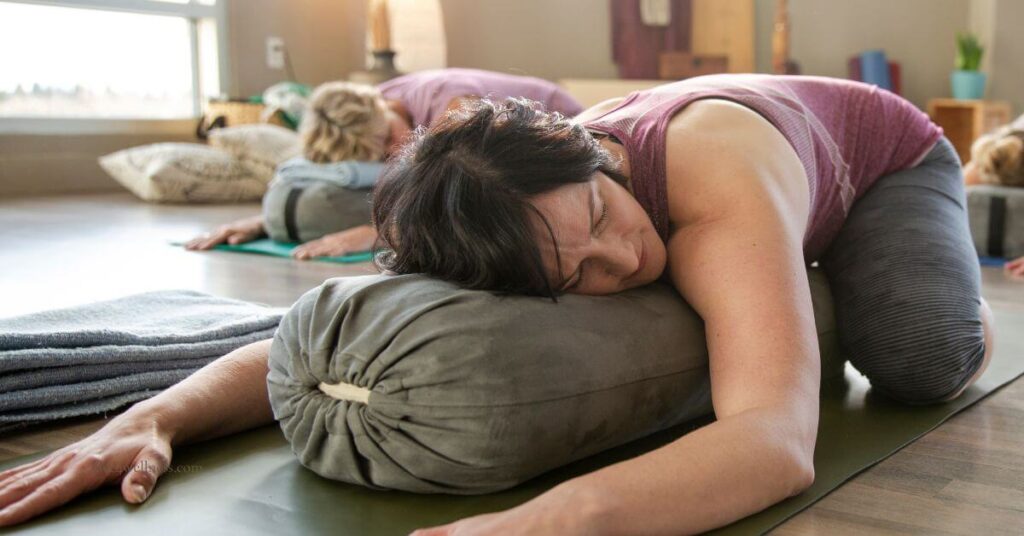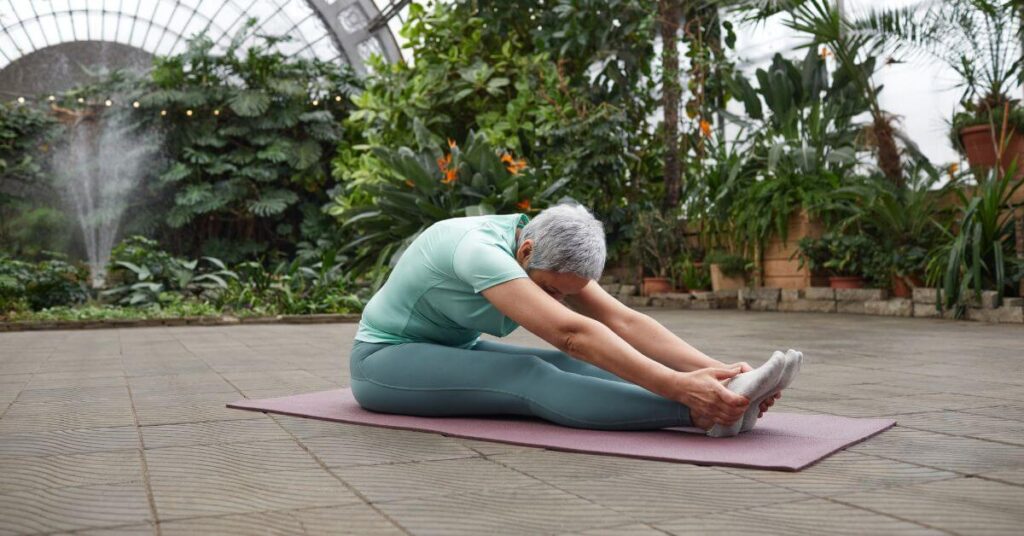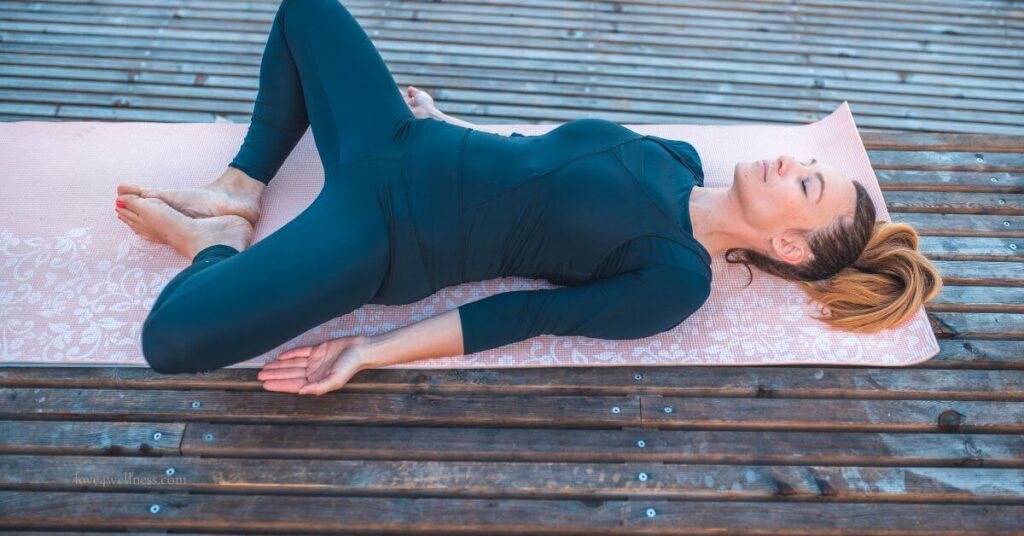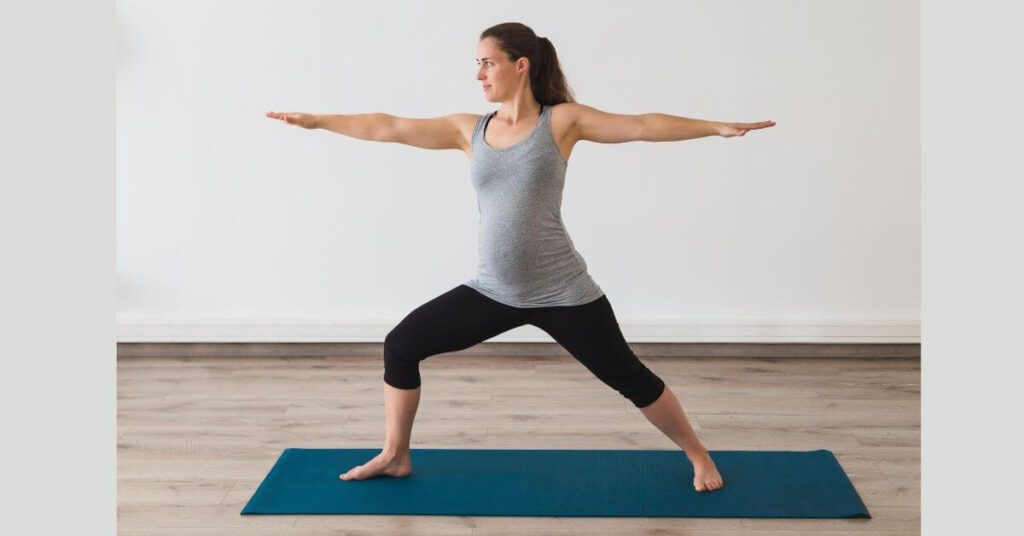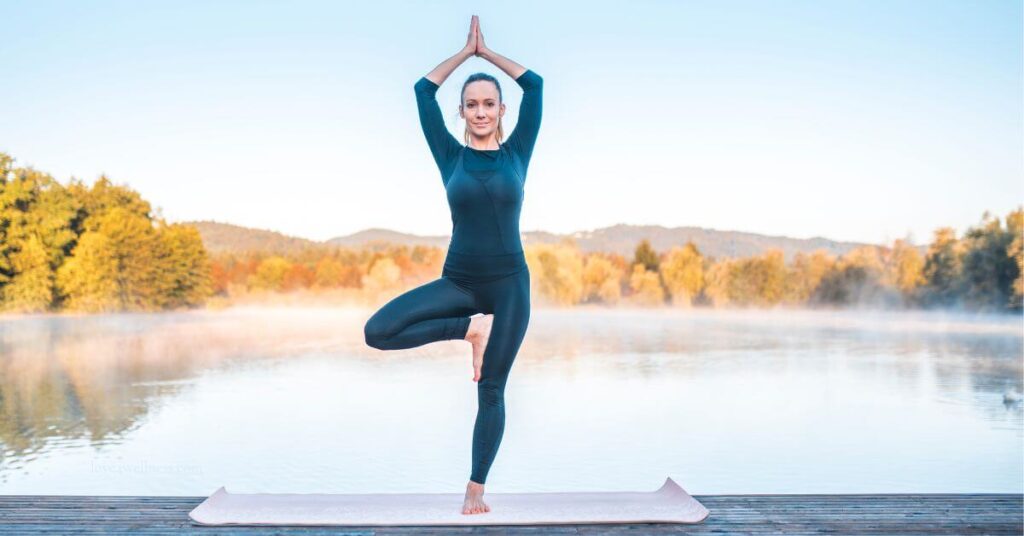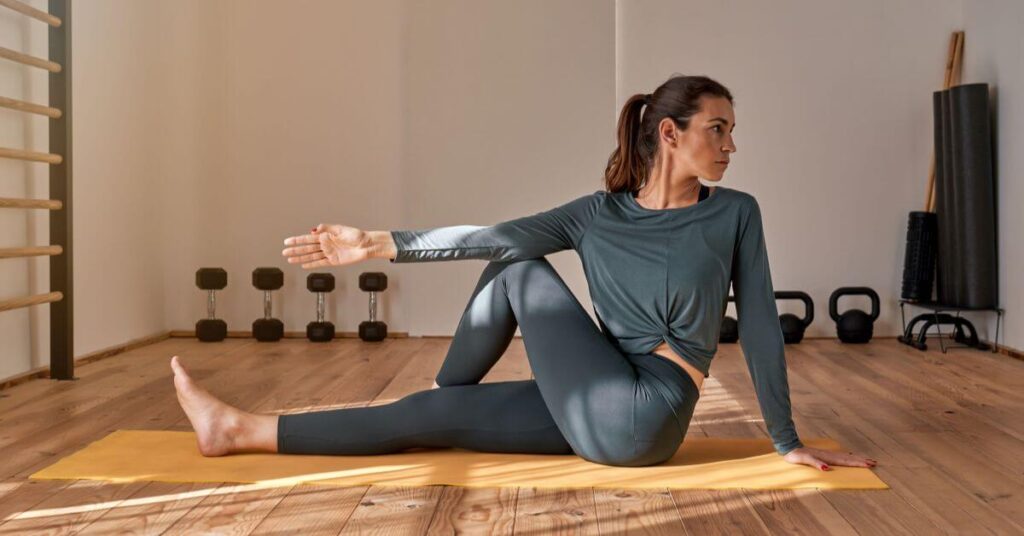That familiar warmth rising up your neck? The sleepless nights? The quiet shift in your mood and energy? If you’re a woman over 40 navigating the twists and turns of menopause, you’re not alone, and you’re likely feeling a lot of things all at once. This natural phase of life brings many changes; while some are subtle, others are more disruptive. But amidst the chaos, there’s a gentle, grounding way to reconnect with your body and mind – gentle yoga for menopause.
This guide is just for you. Whether you’re brand new to yoga or simply looking for a softer, more supportive practice, you’ll find beginner-friendly routines here designed to ease common menopause symptoms like stress, stiffness, fatigue, and mood swings, while helping you feel stronger and more at home in your body. No experience required; just a little time, a quiet space, and a willingness to move with care.
Note: This post is for informational purposes only and does not replace medical advice. Please consult your doctor before starting any new exercise routine, especially if you have health concerns.
7 reasons why gentle yoga helps during menopause
Menopause brings a wave of hormonal shifts that can affect everything from your sleep and mood to your joints and energy levels. Gentle yoga offers a calming, supportive way to ride out these changes with more ease and confidence. Here’s how:
1. Joint-friendly movement
Gentle yoga is low-impact, making it ideal for joints that might feel stiffer or more sensitive during menopause.
2. Natural stress relief
Slow movements paired with mindful breathing help calm your nervous system, easing anxiety, irritability, and emotional ups and downs.
3. Better sleep support
Restorative poses and breathwork help quiet a busy mind, allowing deeper, more restful sleep.
4. Hormone-friendly support
While yoga doesn’t directly balance hormones, it supports key systems, like your nervous and endocrine systems, that play a role in hormonal regulation.
5. Flexibility and strength
Stretching and gentle strengthening movements help maintain mobility, improve posture, and reduce muscle stiffness.
6. Reconnect with your body
Yoga encourages mindfulness and body awareness, helping you attune to your physical, emotional, and mental needs.
7. Beginner-friendly & inclusive
You don’t need to be flexible or experienced. Gentle yoga meets you where you are, with variations for every level and body type.
Also Read:
- Hot Flashes, Sleepless Nights? Here’s How Ayurveda Helps You Glide Through Menopause
- You’re Not Ageing—Your Doshas Are Shifting: Ayurveda for Menopause Skincare Explained
12 gentle yoga poses to support you through menopause
These gentle yoga poses are ideal for nurturing your body and calming your mind during menopause. Breathe deeply, move slowly, and honour how you feel each moment.
1. Supported child’s pose (Salamba Balasana)
How to do it:
Come to a kneeling position with your big toes touching and knees spread apart, just as wide as comfortable. Gently fold forward, resting your torso between your thighs. Extend your arms forward with palms down, or bring them alongside your body with palms up. Let your forehead rest on the mat, a block, or a cushion for added support.
Why it’s helpful during menopause:
This deeply restful pose soothes the nervous system, helps quiet a racing mind, and eases overwhelming feelings. It’s especially helpful for reducing fatigue, tension, and stress, common companions during this phase.
2. Cat–Cow pose (Bitilasana–Marjaryasana)
How to do it:
Begin on all fours in Tabletop Pose, with your wrists under your shoulders and knees under your hips.
- Inhale: Gently arch your back, drop your belly toward the mat, lift your chest, and gaze slightly upward — this is Cow Pose.
- Exhale: Round your spine toward the ceiling, tuck your tailbone and chin, and draw your navel toward your spine — this is Cat Pose.
Continue flowing slowly between these two movements, syncing breath with motion.
Why it’s helpful during menopause:
This rhythmic movement gently massages your spine, improves circulation, and releases tension in the back and neck. It’s energising yet calming – ideal for easing stress, enhancing mood, and promoting a smoother energy flow when you’re feeling off-balance.
3. Legs-up-the-wall pose (Viparita Karani)
How to do it:
Sit sideways with one hip close to a wall. Gently lower your back to the floor as you swing your legs up the wall. Adjust your position so you’re comfortable — your hips can be touching the wall or a few inches away. Let your arms rest by your sides, palms facing up. Close your eyes and soften your breath.
Why it’s helpful during menopause:
This deeply restorative pose soothes the nervous system and encourages circulation. It’s especially helpful for cooling hot flashes, easing tired or swollen legs, and promoting a sense of calm. Practising before bed can also support a more restful sleep.
4. Supported bridge pose (Setu Bandhasana with support)
How to do it:
Lie on your back with your knees bent and feet flat on the floor, hip-width apart. Press into your feet to gently lift your hips. Slide a yoga block, bolster, or cushion under your sacrum (the bony area above your tailbone) for support. Allow your hips to rest fully on the support. Let your arms relax by your sides, palms facing down or up.
Why it’s helpful during menopause:
This gentle backbend can feel uplifting and energising while still deeply calming. It may support thyroid function, aid circulation, and release tension in the lower back. The supported version allows you to relax into the pose, making it ideal for easing stress and restoring emotional balance.
5. Seated forward bend (Paschimottanasana – Gentle variation)
How to do it:
Sit on the floor with your legs extended straight in front of you. If your hamstrings feel tight, keep a soft bend in your knees or sit on a folded blanket for support. Inhale to lengthen your spine, reaching tall through the crown of your head. As you exhale, gently hinge forward from your hips, reaching toward your feet, or rest your hands on your shins, ankles, or knees. Let your head and neck relax. There’s no need to force the stretch; allow your body to ease into it.
Why it’s helpful during menopause:
This soothing pose calms the nervous system, helps release tension from the back and hamstrings, and supports mental clarity and emotional ease. It can be especially grounding if you feel anxious, restless, or fatigued.
6. Reclined butterfly pose (Supta Baddha Konasana – with support)
How to do it:
Lie comfortably on your back. Bring the soles of your feet together and allow your knees to gently fall open to the sides, forming a diamond shape with your legs; for added comfort, place cushions, folded blankets, or yoga blocks under each outer thigh to support your hips. Let your arms rest by your sides, palms facing up. Close your eyes and breathe slowly.
Why it’s helpful during menopause:
This deeply restorative pose gently opens the hips, helps release tension in the pelvis, and encourages a sense of emotional grounding. Its calming effect makes it especially useful for easing anxiety, irritability, and stress.
7. Warrior II Pose (Virabhadrasana II – gentle variation)
How to do it:
Stand tall and step your feet wide apart. Turn your right foot out 90 degrees, and angle your left foot slightly in. Align your right heel with the arch of your left foot. On an exhale, bend your right knee, stacking it above your ankle (or as close as feels comfortable), while keeping your left leg strong and straight. Extend your arms out to the sides at shoulder height, palms down. Soften your gaze over your right fingertips. Keep your shoulders relaxed and your core gently engaged.
Why it’s helpful during menopause:
This empowering pose helps build strength and stability, improves balance and concentration, and can leave you feeling grounded and confident. It’s a gentle way to reconnect with your inner resilience during times of change.
8. Tree pose (Vrksasana – with support if needed)
How to do it:
Stand tall with your weight evenly distributed on both feet. Shift your weight onto your left foot. Place the sole of your right foot on your left inner thigh, calf, or ankle; avoid pressing on the knee. Press your foot and leg gently into each other. Bring your hands to your heart in Anjali Mudra (prayer position) and find a steady gaze (drishti) at eye level. If balance feels tricky, keep your right toes lightly on the floor or use a wall for support. Repeat on the other side.
Why it’s helpful during menopause:
Tree Pose helps enhance balance and mental focus, fosters a sense of inner steadiness, and encourages grounding and confidence—all valuable when your body and mind feel in flux.
9. Tabletop pose (Bharmanasana)
How to do it:
Come onto your hands and knees. Stack your wrists directly under your shoulders and your knees under your hips. Spread your fingers wide for stability, pressing evenly through your palms. Keep your spine neutral—neither arched nor rounded—and gaze gently down at the mat to keep your neck aligned.
Why it’s helpful during menopause:
This gentle yet grounding pose builds strength in the arms, wrists, and core while also supporting spinal alignment. It’s a stable starting point for many other postures and helps you reconnect with your body through breath and mindful movement.
10. Cobra pose (Bhujangasana – Gentle variation)
How to do it:
Lie flat on your stomach with your legs extended and the tops of your feet resting on the mat. Place your palms under your shoulders with your elbows tucked in close. As you inhale, gently press into your hands and lift your chest and head a few inches off the floor. Keep your elbows slightly bent, shoulders relaxed, and neck long. Avoid over-arching your lower back—this is a soft lift, not a full stretch. Gaze forward with a soft focus.
Why it’s helpful during menopause:
This mild backbend opens the chest and abdomen, counteracting slouching and boosting posture. It may help ease back stiffness, lift fatigue, and provide a subtle energy and mood boost—all especially useful during the hormonal fluctuations of menopause.
11. Seated twist (Ardha Matsyendrasana – Gentle variation)
How to do it:
Begin seated with your legs extended in front of you. Bend your right knee and place your right foot on the floor outside your left thigh. Keep your left leg extended or bend it slightly if needed for comfort. Place your right hand behind you for gentle support and your left hand on your right knee. Inhale to lengthen your spine, and as you exhale, softly twist your torso to the right. Keep the twist in the mid-back, and avoid forcing your neck—gaze over your right shoulder only if it feels comfortable. Breathe deeply. Repeat on the other side.
Why it’s helpful during menopause:
This gentle seated twist helps stimulate digestion, release tension in the spine, and support natural detox processes. It’s grounding, calming, and perfect for days when your body needs some extra care without intensity.
12. Corpse Pose (Savasana)
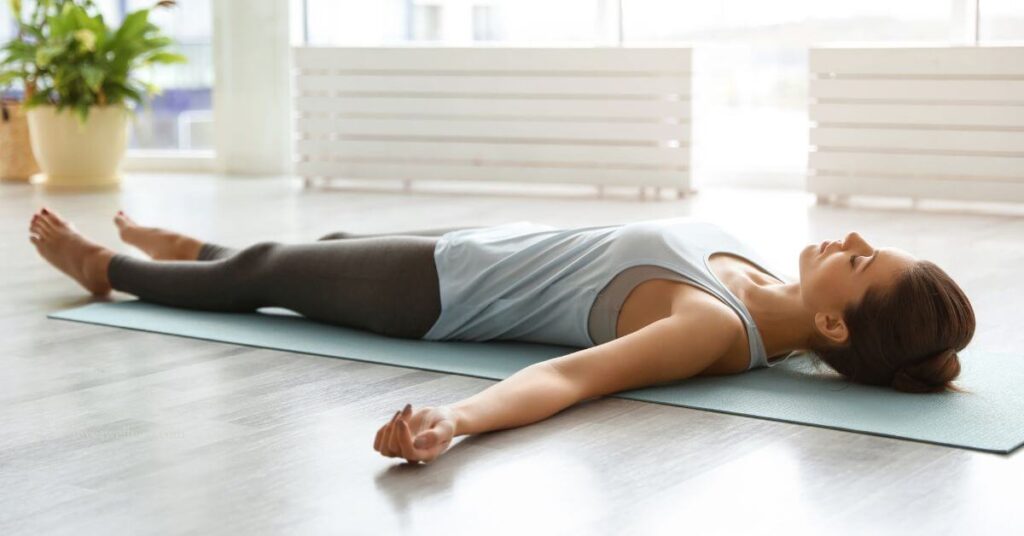
How to do it:
Lie comfortably on your back with your legs extended, arms resting by your sides, and palms facing up. Let your feet relax and fall open naturally. Gently close your eyes. Take a few slow, deep breaths, then allow your breath to return to its natural rhythm. Begin to soften your entire body, releasing tension from your toes, legs, hips, shoulders, jaw, and even the space between your eyebrows. Stay here for 5 to 10 minutes, simply resting and allowing stillness.
Why it’s helpful during menopause:
Savasana offers profound relaxation, helping to soothe the nervous system, reduce stress, and ease fatigue. It gives your body time to absorb the benefits of your yoga practice, while encouraging a deep sense of calm—ideal for managing the emotional and physical shifts of menopause.
Sample beginner gentle yoga routine for menopause
Here’s a short sequence you can try:
- Tree pose (1-2 minutes)
- Warrior pose (hold for 30 seconds on each side, repeat 2-3 times)
- Supported Child’s Pose (2-3 minutes)
- Cat-Cow Pose (5 gentle rounds)
- Table Top Pose (brief hold)
- Cobra Pose (gentle lift, hold for a few breaths, repeat 2-3 times)
- Seated Forward Bend (gentle, hold for 5-7 breaths)
- Seated Twist (gentle, five breaths per side)
- Legs-Up-the-Wall Pose (5-7 minutes)
- Supported Bridge Pose (1-2 minutes)
- Reclined Butterfly Pose (1-2 minutes)
- Savasana (5-10 minutes)
Remember to move slowly, listen to your body, and breathe deeply throughout the practice.
Extra tips for a supportive, gentle yoga practice during menopause
- Honour your body: Some days you might have more energy than others. Adjust your practice accordingly. Rest when you need to.
- Breathe deeply: Focus on long, slow, and even breaths. This is key to calming the nervous system.
- Prop up: Don’t hesitate to use cushions, blankets, and blocks to make poses more comfortable and accessible.
- Little and often: Even 10-15 minutes of gentle yoga a few times a week can make a difference. Consistency is more important than long, intense sessions.
- Find your tribe: Consider joining a gentle yoga class or connecting with other women practising yoga during menopause for support and inspiration.
- Stay hydrated: Drink plenty of water before and after your practice.
The bottom line
Menopause is a profound and personal transition—one that invites care, compassion, and reconnection. Gentle yoga can be a steady, supportive companion through it all. With mindful movement and conscious breathing, you can ease discomfort, calm your mind, and nurture a stronger connection with your changing body.
Embrace this chapter with softness and strength. Let yoga be your tool for balance, resilience, and well-being – from the inside out.
Images: canva.com

